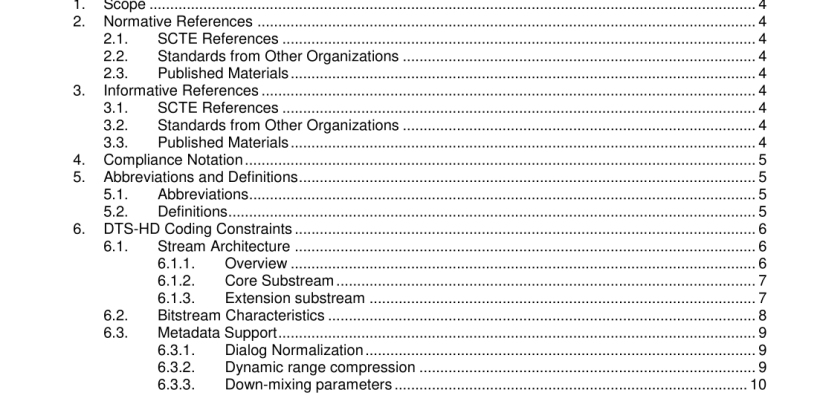ANSI SCTE 194-1-2018 pdf download.Coding Constraints for Cable Television
2. Normative References
The following documents contain provisions, which, through reference in this text, constitute provisions of this document. At the time of Subcommittee approval, the editions indicated were valid. All documents are subject to revision; and while parties to any agreement based on this document are encouraged to investigate the possibility of applying the most recent editions of the documents listed below, they are reminded that newer editions of those documents might not be compatible with the referenced version.
4. Compliance Notation
shall This word or the adjective “required” means that the item is an absolute requirement of this document. shall not This phrase means that the item is an absolute prohibition of this document. forbidden This word means the value specified shall never be used. should This word or the adjective “recommended” means that there may exist valid reasons in particular circumstances to ignore this item, but the full implications should be understood and the case carefully weighted before choosing a different course. should not This phrase means that there may exist valid reasons in particular circumstances when the listed behavior is acceptable or even useful, but the full implications should be understood and the case carefully weighed before implementing any behavior described with this label. may This word or the adjective “optional” means that this item is truly optional. One vendor may choose to include the item because a particular marketplace requires it or because it enhances the product, for example; another vendor may omit the same item. deprecated Use is permissible for legacy purposes only. Deprecated features may be removed from future versions of this document. Implementations should avoid use of deprecated features.
A range of bytes that can be reliably parsed from the bitstream, often formatted having a start code, a byte size and a checksum veri fication The primary component of a core substream, excluding extension coding blocks A part of an asset that may or may not be decoded independently An audio stream component that adheres to the original DTS Coherent Acoustics definition (see Chapter5ofTS 102 114 [1]) Parameter in the core header that may be used to calculate dialog normalization correction. Time represented by one decoded audio frame, may be represented in audio samples per channel at a specific audio sampling frequency or in seconds Parameter in the core header indicating the presence of dynamic range compression coefficients at the beginning of each subframe. An audio stream component providing a specific enhancement or coding profile An audio stream component utilizing the DTS-HD substream header (see Chapter 7 ofTS 102 114 [1]) Loudness, K-weighted, relative to full scale, measured with equipment that implements the algorithm specified by ITU-R Rec. BS.1770 [2];a unit of LKFS is equivalent to a decibel Portion of the PES packet following the PES header The selection within the bitstream being rendered to output channels. Sequence of synchronized frames comprising one of the logical components of the audio stream
The extension substream also consists of a series of synchronized extension frames. If both a core and extension substream exist, the core and extension frames are interleaved in presentation order. An extension frame consists of an extension header, and coded data for up to eight assets. Only the first asset may be dependent on the core substream.ANSI SCTE 194-1-2018 pdf download
